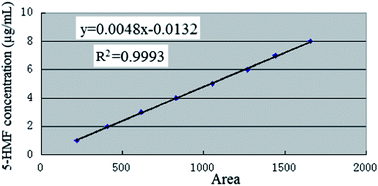Synthesis and evaluation of stable polymeric solid acid based on halloysite nanotubes for conversion of one-pot cellulose to 5-hydroxymethylfurfural
Abstract
Based on halloysite nanotubes (HNTs), precipitation polymerization and Pickering emulsion polymerization were firstly adopted to synthesize two composites i.e. HNTs–polystyrene(PSt)–polydivinylbenzene(DVB)(I) and HNTs–PSt–PDVB(II), respectively. After sulfonation by 98% H2SO4, two polymeric solid acid catalysts i.e. HNTs–PSt–PDVB–SO3H(I) and HNTs–PSt–PDVB–SO3H(II) were successfully prepared for conversion of one-pot cellulose to 5-hydroxymethylfurfural (HMF) in an ionic liquid 1-ethyl-3-methyl-imidazolium chloride ([EMIM]-Cl). Characterization of two catalysts showed that HNTs–PSt–PDVB–SO3H(I) possessed superior hydrophobicity, content of –SO3H groups, and total acidic amounts to those of HNTs–PSt–PDVB–SO3H(II), but with less very strong acidic sites and non-uniform morphology. Then the amount of the catalysts, reaction time and reaction temperature were optimized for cellulosic conversion over the two catalysts, and a maximum yield of 28.52% for HNTs–PSt–PDVB–SO3H(I) and 32.86% for HNTs–PSt–PDVB–SO3H(II) under the optimized conditions was obtained, indicating very strong acidic sites played a key role in cellulose conversion. In addition, the two as-prepared catalysts could be very easily recycled at least five times without significant loss of catalytic activity.


 Please wait while we load your content...
Please wait while we load your content...